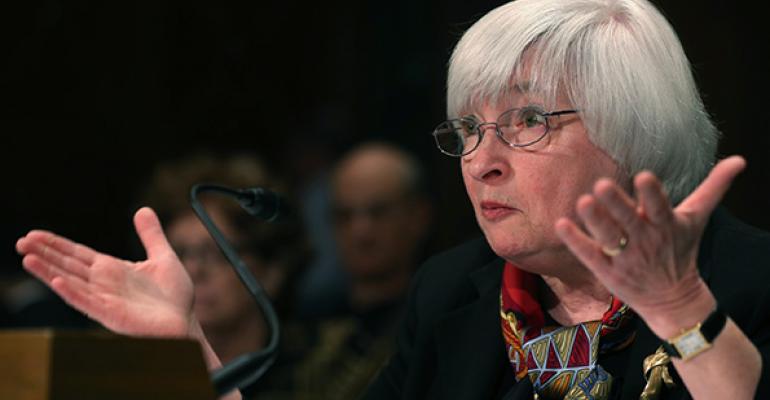By Matthew Boesler and Steve Matthews
(Bloomberg) --Policy discussions when the Federal Reserve last met may show greater confidence in the inflation outlook and a debate over options for winding down the U.S. central bank’s massive bond portfolio, feeding discussions over the timing of the next interest-rate increase.
The record of the Jan. 31-Feb. 1 meeting, at which officials voted to leave the target range for the federal funds rate unchanged at 0.5 percent to 0.75 percent, is scheduled to be released Wednesday at 2 p.m. in Washington.
The rate-setting Federal Open Market Committee published a statement following its meeting that shed little new light on how participants viewed the outlook, or the potential for fiscal policy stimulus from President Donald Trump. Investors expect at least two quarter-point rate hikes this year, according to prices in federal funds futures contracts, though they see the Fed staying on hold at the next FOMC meeting on March 14-15.
“The statement was un-nourishing, which whets the appetite for more on the Fed’s view of fiscal policy, financial excesses, the timing of balance sheet reduction, and the evolution of inflation,” said Carl Tannenbaum, chief economist at Northern Trust in Chicago. Chair Janet Yellen’s testimony to Congress last week also avoided giving much away, he added.
‘Stronger Language’
In its Feb. 1 statement, the FOMC omitted previous references to weakness in energy prices and a stronger dollar holding inflation below its target, saying it expected “inflation will rise to 2 percent over the medium term.”
“There was stronger language in the statement on inflation, so it will be interesting to see any color on their outlook,” said Sam Bullard, senior economist at Wells Fargo Securities LLC in Charlotte, North Carolina. The minutes may show the extent to which committee participants feel comfortable allowing inflation to run above their target for a time, he said.
A discussion of when and how to shrink the Fed’s $4.5 trillion balance sheet, amassed through three rounds of bond-buying designed to lower borrowing costs after short-term rates were cut to zero, may also appear in the record of the meeting. A number of officials have said recently that it’s time to start talking about the balance sheet.
“What I am looking for is balance sheet discussion, and that, I think, will be the most useful thing to come out of this,” said Shehriyar Antia, chief market strategist at Macro Insight Group in New York. The increasingly public discussion by Fed officials on the topic is a signal that the process of coming up with a strategy to shrink the balance sheet would now gather steam, said Antia, a former policy adviser at the New York Fed.
Trump Policy
While the Trump administration’s plans for economic policy could weigh significantly on the U.S. economic outlook, the minutes may offer few clues on how Fed officials view the likely impact. Minutes of their previous meeting in December emphasized the uncertainty surrounding policy proposal details and chances of implementation, a theme central bankers have continued to stress in public.
“Participants would be reluctant to say anything about fiscal policy at the meeting,” said Jonathan Wright, an economics professor at Johns Hopkins University in Baltimore who helped draft previous versions of minutes in his time as a Fed economist. “It is obviously important, but I don’t think the FOMC wants to be in the business of forecasting what fiscal policy will be.”
Many survey measures of business and consumer confidence have risen markedly since the Nov. 8 U.S. presidential election, and the minutes may feature a discussion on the extent to which increased confidence may feed through to official data on economic activity.
“We expect there to be a mention of the meaningful improvement in business and consumer sentiment surveys,” Bank of America Merrill Lynch economists led by Michelle Meyer wrote in a Feb. 17 report. “There may be some debate over the importance of these indicators as a signal for the real economy.”
Officials will see fresh government data on jobs and inflation between now and the FOMC’s meeting next month.
To contact the reporters on this story: Matthew Boesler in New York at [email protected] ;Steve Matthews in Atlanta at [email protected] To contact the editors responsible for this story: Brendan Murray at [email protected] Randall Woods, Alister Bull





